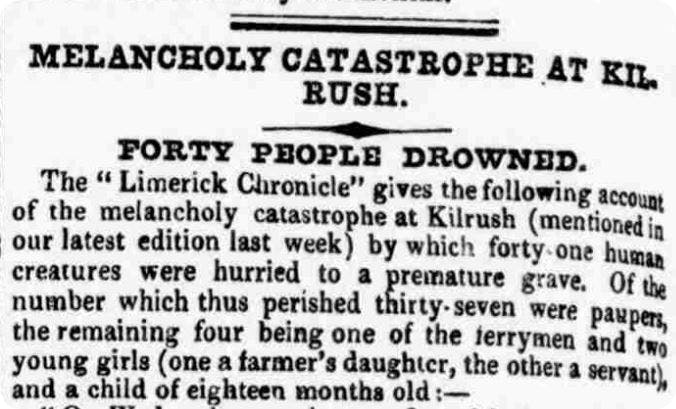Did your ancestors experience the Great Irish Famine?
3-4 minute read
By Niall Cullen | May 1, 2020

How to find family who lived through The Great Irish Famine (1845-52), the greatest single tragedy in Ireland's history.
Few aspects of life in Ireland were spared the effects of the Great Irish Famine. The devastating wave of poverty, hunger, disease, death and displacement that came in the wake of the failure of the country's potato crops completely changed Irish society forever.
Search Irish records online now
Enter a few details to see your family’s records at your fingertips.
If you have Irish heritage, your family may have endured this dark period in Irish history and there are ways to find out. Findmypast's extensive Irish family records, the largest collection online, can unlock Irish Famine stories and help you trace ancestors who lived through it.
Examining newspapers and crime records can rebuild a picture of events in Ireland at the time. In land records, you'll see the seeds of change in landlord/tenant relationships brought to the fore by the Famine. While millions of emigration and census records follow the Irish diaspora as they escape the hardship in Ireland and move around the globe, a lasting legacy of an Gorta Mór (The Great Hunger).
Here's a closer look at some of the resources that can help you find Famine ancestors and shape your Irish family story.
Poverty Relief Loans 1821-1874
You can discover details of the poorest families in rural Ireland before, during and after the Famine with this fascinating record collection.

This map shows the geographic coverage of the Poverty Relief Loan records, with a focus on rural areas in the west and south.
Poverty relief loans were given to struggling farmers to help them survive as their crops failed. The records reveal all sorts of useful family tree information including names, addresses and the names of loan guarantors or witnesses, often other family members or neighbours.
Irish Famine Immigrants, 1846-1851
Between 1846 and 1852 almost 1.5 million Irish men, women and children left their homeland in search of a better life. The Irish Famine Immigrants transcripts list over 420,000 Irish people who disembarked in the United States between 1846 and 1851. Of those, 8,000 were born on board ship and up to 10% of those who originally came aboard are thought to have died at sea.
Our records group together individuals with the same surname who travelled on the same ship, a useful feature as you trace your ancestors forward in US census records.
Workhouse and poor law records
During the Great Famine, Irish workhouses, built to hold up to 100,000 residents and funded by local taxation, were overwhelmed by the sheer numbers of those in need. The records left behind from the time are must-search resources for tracing Famine family and Findmypast is home to the most comprehensive collection online. The following collections all include records from the Great Famine period.
- Dublin Workhouses Admission & Discharge Registers 1840-1919
- Dublin Poor Law Unions Board Of Guardians Minute Books
- Donegal Workhouses Registers and Minute Books
- Waterford Poor Law Union Board Of Guardians Minute Books
- Galway Poor Law Union Records
- Clare Poor Law Unions Board Of Guardians Minute Books
- Sligo Workhouse Admission and Discharge Registers 1848-1859
Often, you'll discover entire families listed together in workhouse registers, while board of guardian minutes books should mention anyone involved in the running of the overcrowded institutions.
Newspapers
Newspaper accounts from the time cover all aspects of the Famine, or as it's described in many, ‘distress in Ireland’.
The ‘who, when, what, where, why’ 19th-century reporting style makes newspapers a name-rich source for anyone tracing their past. National newspapers received a lot of their stories from local and regional press, giving us access to community news,even where those smaller newspapers do not survive.

Roscommon Journal, and Western Impartial Reporter, 4 May 1850
The coverage ranges from the culpability of government and landlords in prolonging and exacerbating the plight of the millions of rural labourers and tenant farmers to reports focusing on the human stories.

Lloyd's Weekly Newspaper, 23 December 1849
The newspaper reports of the time did not shy away from graphic details of the effects of starvation. This sensationalist approach to reporting such harrowing events could be condemned but it also gives us a deeper understanding of the very real suffering throughout the country.
Crime records
Did the Famine create a crime wave in Ireland? Our prison and court records tell the story.
Given the desperation in Ireland at the time, it is perhaps unsurprising then that many people turned to petty crime to feed themselves. In fact, some committed crimes in the hope of being imprisoned, where they would at least be sheltered and fed. Prison rations were kept deliberately low for the first two weeks of imprisonment to discourage people from this drastic course of action.

Brother and sister, Patrick, aged 11, and Mary Mooney, aged 9, were imprisoned for five days in November 1847 in Galway for ‘asking alms’ (begging).
Others were caught up in the stringent vagrancy laws of the day. Straying too far from home for too long in search of help could result in being imprisoned for up to a month. Being homeless could also see you imprisoned, a cruel twist for those already suffering after eviction.
Although it can be uncomfortable and, at times harrowing, to explore the history of the Great Irish Famine, our ancestors' stories from the tragedy deserve to be preserved and shared. After all, they've helped shape who we are today. Let us know what you've discovered on Facebook, Instagram or Twitter using #WhereWillYourPastTakeYou?
Related articles recommended for you

'Their hunger will not allow them to continue': the victorious London dockers' strike of 1889
History Hub

More footballers in the family? Jack Grealish’s family tree
Discoveries

Explore new parish records and school registers
What's New?

